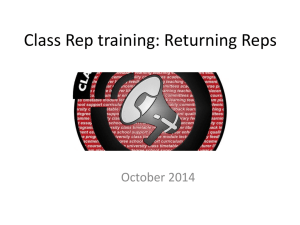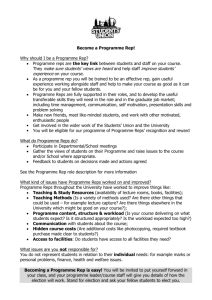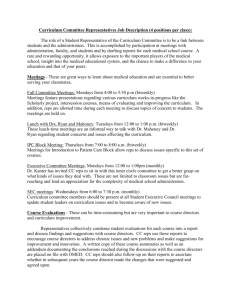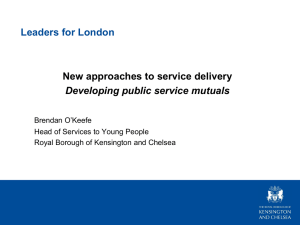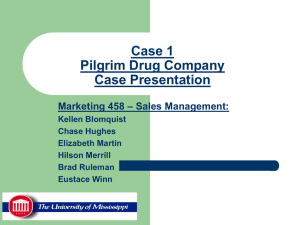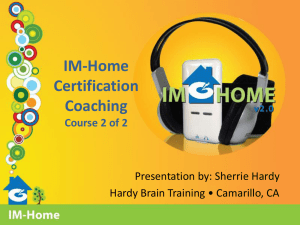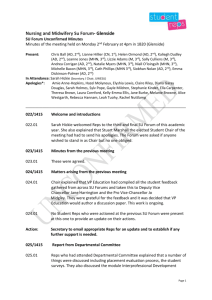Curriculum: Sales Leader (VP and above)
advertisement
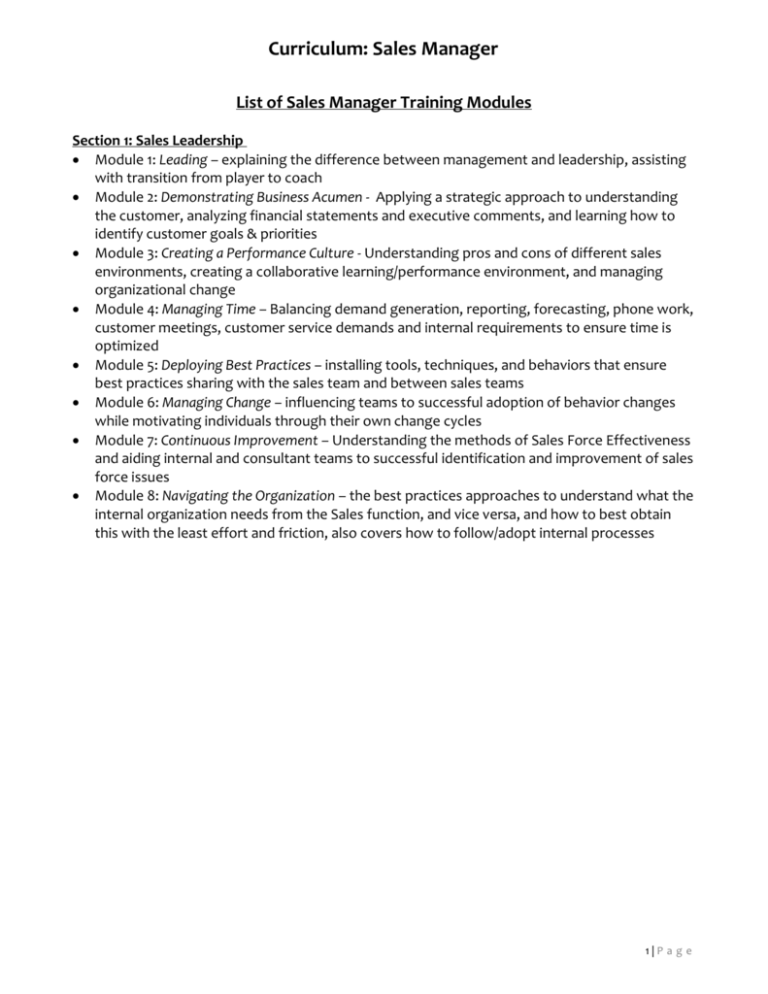
Curriculum: Sales Manager List of Sales Manager Training Modules Section 1: Sales Leadership Module 1: Leading – explaining the difference between management and leadership, assisting with transition from player to coach Module 2: Demonstrating Business Acumen - Applying a strategic approach to understanding the customer, analyzing financial statements and executive comments, and learning how to identify customer goals & priorities Module 3: Creating a Performance Culture - Understanding pros and cons of different sales environments, creating a collaborative learning/performance environment, and managing organizational change Module 4: Managing Time – Balancing demand generation, reporting, forecasting, phone work, customer meetings, customer service demands and internal requirements to ensure time is optimized Module 5: Deploying Best Practices – installing tools, techniques, and behaviors that ensure best practices sharing with the sales team and between sales teams Module 6: Managing Change – influencing teams to successful adoption of behavior changes while motivating individuals through their own change cycles Module 7: Continuous Improvement – Understanding the methods of Sales Force Effectiveness and aiding internal and consultant teams to successful identification and improvement of sales force issues Module 8: Navigating the Organization – the best practices approaches to understand what the internal organization needs from the Sales function, and vice versa, and how to best obtain this with the least effort and friction, also covers how to follow/adopt internal processes 1|P a g e Curriculum: Sales Manager Section 2: Selling Skills Module 9: Needs Development – Developing sales reps skills necessary to unearth, define, develop needs in the customer/prospect accounts. Also includes coaching reps to uncovering latent needs as well as developing Challenger sales skills. Module 10: Buyer Personas and Journeys – Understanding the various types of buyers, their perspectives and the buying processes they go through; coaching sales reps to effectively leverage this buyer mindset. Module 11: Social Selling – Coaching and continuous assessment of sales reps as they leverage social media for sales campaigns and prospecting Module 12: Marketing Leverage – Leading sales reps to avail themselves of Marketing assistance in terms of demand generation, marketing-provided content & tools, account segmentation, and lead management. Also necessary to lead teams to take an outside-in tone, even if Marketing has not done so yet. Module 13: Taking the Customer View -- Developing sales reps skills necessary to perform actionable discovery, conduct active listening, and re-present account-related information from the perspective of the customer/prospect Module 14: Building a Business Case -- Developing sales reps skills necessary to assemble a convincing business justification based on figures of merit, threshold values, sensitivity analyses, and other artifacts of financial management Module 15: Articulating a Value Proposition – Developing sales reps skills necessary to develop compelling content, present it using persuasive written and verbal techniques, and move customers/prospects to action Module 16: Solution Development – Developing sales reps skills necessary to brainstorm multiple alternate solution options, each with different risk/reward attributes, benefit realizations, terms and conditions, and implementation specifics but that all solve customer/prospect problems in a different way Module 17: Negotiating – Developing sales reps skills necessary to use give-get frameworks successfully, obtain relevant win-win outcomes, persuade other via written and oral means to either change their minds or adopt different approaches, all in the course of negotiating contracts for future work Module 18: Account Development and Support – Developing sales reps skills necessary to transform assigned existing customers into reliable reference and referral sources, to greater commitment of revenue to the company/solution, and greater integration into the key/Global account management program 2|P a g e Curriculum: Sales Manager Section 3: Sales Management Module 19: Managing Territories - overseeing the deployment of resources around proper territory allocation, setting quotas, assigning and overseeing accounts Module 20: Funnel/Pipeline Management – using CRM to enhance forecasting accuracy, sales campaign advancement and gap analysis (e.g. Tracking: buying behavior, lead source, pipeline advancement, closing ratios, average sales price, Win/Loss, etc.) Module 21: Assessing Sales Rep Process Execution – oversight of sales rep execution of sales process steps, job aid usage, and adoption of specific guidance Module 22: Performing your role in the Sales Process – addresses all requirements of the sales manager as a participant in the sales process (sales calls, presentation review, proposal development) Module 23: Auditing Team Performance – how sales managers introduce quality control and an audit cadence into their tasking Module 24: Delivering Situational Leadership – how to lead, manage, and coach based on a sales rep developmental model Module 25: Running a Training Meeting – Determining the topics, creating content, establishing guidelines, ensuring retention, conducting role plays, collecting feedback, building in pre-work, and using post-training reinforcement activities Module 26: Co-opting 3rd party Organizations – the tasks and behaviors that enable managers to co-opt partners, influencers, and other 3rd parties in the sales mission Module 27: Receiving Executive Mentorship – how, when, and why to receive mentorship from an executive as part of a personal development plan Module 28: Mentoring Others – steps sales managers can take to raise the competency of junior peers 3|P a g e Curriculum: Sales Manager Section 4: Talent Management and Development Module 29: Conducting one-on-one Rep Coaching -- coaching and training elements of prospecting, selling and lead qualification Module 30: Developing Future Leaders – recognize future leadership talent, assign developmental activities, and ensure proper attention is given to future sale leaders to prepare them for a future leadership position Module 31: Virtual Reinforcement – techniques for reinforcing training and new initiatives including embedding content into the Learning Management System (LMS) Module 32: Measuring Performance – Using a Proactive performance management as an early warning system; leveraging metrics and benchmarking, conducting sales-related analysis; understanding how to map and leverage trends in the business Module 33: Conducting Performance reviews – Taking he steps a manager to prepare, deliver, and follow-up on individual sales rep performance reviews Module 34: Supporting the Onboarding of new Sales Reps – Overseeing the adoption of a structured framework of learning components and execution steps to onboard new hires sales reps and reduce their ramp time to full sales productivity Module 35: Interviewing – Performing the activities to phone screen, perform competency interviews, work and life history reviews, and perform reference interviews – all necessary to attract, screen, qualify, and hire sales rep new hire candidates Module 36: Building a Virtual Bench – Nurturing a stable of ‘A’ player sales rep candidates from the industry, competitors, and partners using a variety of tools, techniques, and budgeted time Module 37: Building a Recognition System – ensure positive reinforcement and recognition processes are in place to motivate and retain “A” player sales talent Module 38: Managing a multi-generational/multi-cultural sales force – Understanding the nuances of having multiple generations and cultures work together on teams for the highest benefit of the sales force, company, and customers. Includes learning content on how to manage sales and channel forces in multiple countries/regions. Module 39: Managing a virtual, mobile-enabled team – adequately leveraging technology and ensuring sales reps are correctly using mobile capabilities for the most effective results 4|P a g e Curriculum: Sales Leader (VP and above) Section A: Executive Sales Leadership Modules In addition to exhibiting prowess in all Sales Manager modules, the Sales Leader will also participate in these intense modules. The below modules include lecture, in-class exercises, written/oral examinations, and real-life measured application. Module A1: Visionary Leadership – Via forward-thinking character, communicates the vision and strategies that will lead to long-term growth, value, and opportunity. Keeps everyone aligned to the overall direction of the sales organization as it serves the company’s strategies. Willing to take calculated risks. Is innovative, open-minded, and flexible; recognizes current market and buyer trends and is able to translate them to long-term change requirements for the organization. Module A2: Developing Leaders/Succession Planning– recognizing future leadership talent, assigning developmental activities, and ensuring proper attention is given to future executive sale leaders to prepare them for leadership succession. Assessing and identifying current sales leaders and their contribution (or lack of) to the sales organization and the company. Proactively managing sales leaders before negative impacts occur due to the wrong people in the wrong roles. Module A3: Motivational Leadership – Energizing partners and stakeholders to excel and gaining commitment to the sales vision and strategies. Maintains a positive and enthusiastic environment even in adverse situations among Sales and other organizations. Module A4: Challenging Leadership – Consistently achieves superior results. Cuts to the essence. Makes bold, timely decisions. Makes tough calls when necessary. Takes responsibility and does not pass on blame. Insists on high standards of performance. Sets and achieves high expectations of self and others on team. Module A5: Management of Change – Through character traits of resilience and optimism, is able to leverage change positively. Has experience in turning around a struggling department/operation/group. Implements positive change strategies through others. Gains partner support and leads through change positively yet pragmatically. Exhibits enough transparency and commitment to inspire others to adoption of the change. Module A6: Executive Acumen – Able to craft strategy and lay out the tactical implementation necessary to meet strategy; administratively organized; continuously learning. Is selfdisciplined; controls emotional reactions and keeps personal biases out of the decision making process. Stays abreast of current business and industry trends. Stays on top of the numbers and trends in his/her area of responsibility, and the numbers and trends of the entire corporation. Exudes executive demeanor and confidence. Understands how changes in other company organizations impact the Sales organization and acts accordingly. Module A7: Customer Experience – Attuned to the whole realm of customer touchpoints and how to leverage each one for potential (but appropriate) sales opportunities. Balancing the efforts and returns of sales functions with implementation and customer service functions. Driving the organization to recognize the opportunity that exists in providing stellar seamless customer experience. Module A8: Personal Branding – Aware of and proactively managing a personal brand that is congruous with company values, portrays thought leadership, and exudes influence for company offerings and brand values. 1|P a g e


